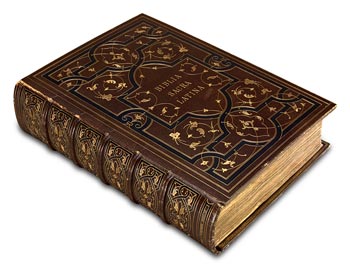 When it left Kleinbautzen, the Old Testament copy was in a pigskin binding in oak boards, almost certainly not the original binding, since the leaves had been trimmed so severely that some of the illumination is missing as well as a portion of the 1565 inscription recording Opitz's gift to Gaubisch. Besides some worming in the boards and the first and last leaves, the book was said to be "in very good condition" and to have suffered only from being kept so long in the damp environment of the sacristy. The London bookbinding firm of Francis Bedford restored the volume sometime before it was sold at Sotheby's. Probably Bedford was responsible for making the facsimile leaf II, 162 and the facsimile portion of II,182.
When it left Kleinbautzen, the Old Testament copy was in a pigskin binding in oak boards, almost certainly not the original binding, since the leaves had been trimmed so severely that some of the illumination is missing as well as a portion of the 1565 inscription recording Opitz's gift to Gaubisch. Besides some worming in the boards and the first and last leaves, the book was said to be "in very good condition" and to have suffered only from being kept so long in the damp environment of the sacristy. The London bookbinding firm of Francis Bedford restored the volume sometime before it was sold at Sotheby's. Probably Bedford was responsible for making the facsimile leaf II, 162 and the facsimile portion of II,182.
Theodore Irwin decided that the Old Testament copy deserved a more ambitious binding. Like other collectors of his day, he would not have hesitated to replace purely utilitarian pigskin with something more impressive and artistic, something that would display the full value and importance of a prize acquisition. In 1885 he had it rebound by William Matthews (1822–1896), the most prominent American bookbinder at that time, trained in London and active in New York where he worked on his own account and for the firm of D. Appleton & Company until he retired in 1890. Matthews made his name with a binding now at the Morgan, a copy of the Owen Jones Plans, Elevations, Sections, and Details of the Alhambra (1842) decorated in the Moorish style, an impressive folio awarded the highest honors at the New York World's Fair of 1853. He was a member of the Grolier Club, which published his lecture Modern Bookbinding Practically Considered (1889) in a luxurious edition of three hundred copies. The president of the Grolier Club, Samuel Putnam Avery, wrote an obituary of Matthews that praises him for being "familiar with the history of his craft, an exponent of its essential principles, a student of its esthetic possibilities."
Aesthetics appear to have prevailed over history in Matthews's design for this volume, the covers decorated with Grolieresque strapwork and gilt-tooled arabesques, the inside borders finished with "Aldine" tools. The binding is in a dark brown morocco with vellum pastedowns and flyleaves, the edges gilt "without one particle being taken off." To protect it, Matthews made a morocco case lined with chamois (now replaced with a linen box case conforming to current conservation standards). He charged a total of $294.25 for the work performed on this volume, a precise figure no doubt calculated on the basis of time and materials, comprising his contributions to the project and those of the forwarders and the finisher. His invoice has been preserved along with an accompanying letter where he notes that "the design we selected is very satisfactory to me" and that the finisher had done his job "excellently well."
Plan your visit. 225 Madison Avenue at 36th Street, New York, NY 10016.
Plan your visit. 225 Madison Avenue at 36th Street, New York, NY 10016.
